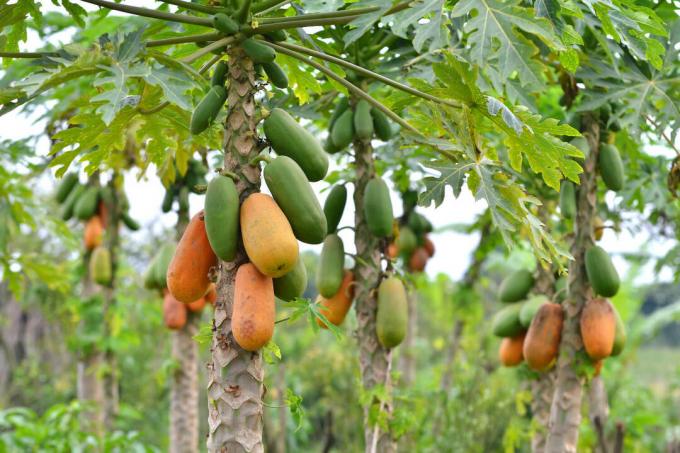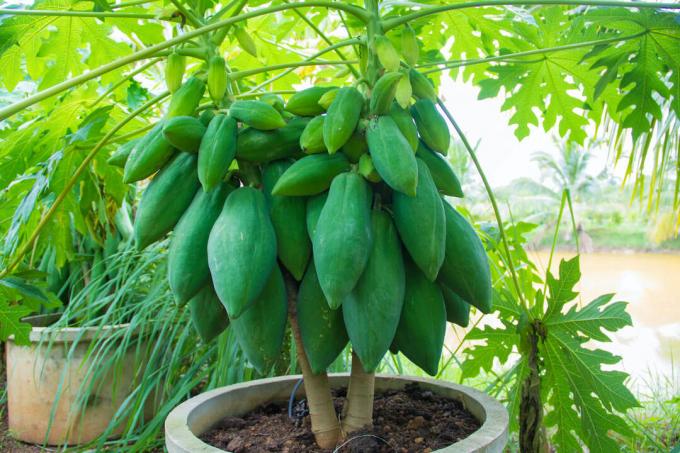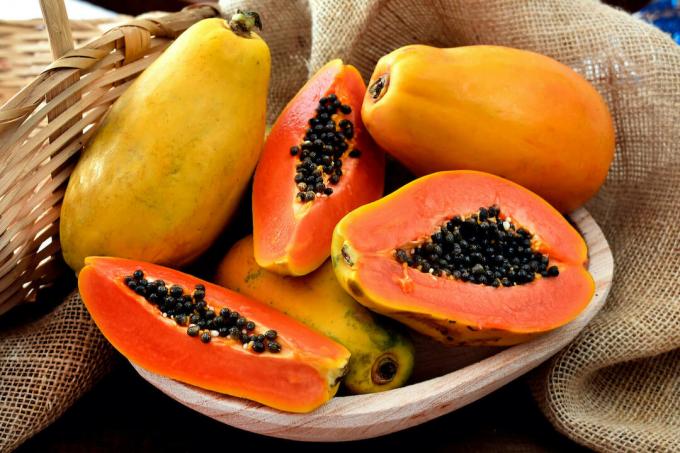With the right care, it is even possible for us to plant papaya seeds and grow papayas from them yourself. In addition to being used as seeds, the papaya kernels are also edible.

The papaya (Carica papaya) is a tropical plant with amazing properties. But even here it is possible to grow papayas yourself. The following article reveals how this works and how to properly care for a papaya.
contents
- Papaya plant: origin and properties
- Plant papaya seeds and grow them yourself
-
care and overwintering
- watering and fertilizing
- repot
- diseases and pests
- Is papaya hardy?
- Can you harvest homegrown papayas?
Papaya plant: origin and properties
The name papaya probably comes from the Central American Arawak Indians, who called this plant the "tree of health". Botanically, it belongs to the melon tree family (Caricaceae) and originally comes from Mexico. Nowadays papaya is grown in tropical and subtropical areas such as Australia, India, Central and South America and Africa. The papaya is also called papaya tree, melon tree, tree melon or melon tree fruit.
Papayas are evergreen, semi-woody perennials that grow like trees. As a container plant, the papaya can reach a height of 3 to 4 m, in its natural environment it is even larger.
The trunk of the papaya is hollow inside or filled with spongy tissue, few branches and incompletely lignified. There is milky sap throughout the papaya plant, the root system is fairly flat and widely spread.
The long-stemmed, alternate leaves form a kind of tree crown in the upper part of the papaya. Leaves growing further down die off again and again, leaving leaf scars. The papaya leaves can easily be over half a meter tall, with the deeply lobed leaf shape resembling a hand.

The papaya flowers offer a wide variety of shapes and colors. Depending on the species, they can be white, yellow, or cream in color. The most common type Carica papaya bears small, white, star-shaped flowers that look like propellers. They form on the leaf scars of dead leaves. With the papaya, flowers and fruits can be found on one plant at the same time. papayas are dioecious plants – that is, a plant bears either exclusively male or exclusively female flowers. Accordingly, two plants of different sexes are always necessary for successful pollination. After 10 to 14 months, the first flowers will form and soon the first fruits will appear.
Depending on the species, the oval fruits with a green-yellow skin weigh between 500 g and 5 kg. Because the Differentiation between fruits and vegetables is not clear, the papaya cannot be specifically classified either. The unripe fruit is prepared like a vegetable, while the ripe papaya is eaten fresh and is known for its sweet taste. The flesh is initially white and turns yellowish-orange or red as it ripens. The black seeds are in the cavity of the fruit. They are the size of peppercorns and are usually not eaten.
tip: How to eat a papaya, you can find out from us.
If the papayas are harvested unripe, they can ripen later because they are climacteric fruits. This means that their cellular respiration after plucking from the tree drives the ripening process even further.

Plant papaya seeds and grow them yourself
Since the papaya is originally native to the tropical climate, it can only be reared as a houseplant and later in a bucket in the conservatory, on the terrace or on the balcony. A consistently warm place is optimal for sowing and germination. Here, for example, a greenhouse or the windowsill are ideal. The young papaya plant likes it bright, warm and with a humidity of over 60%. From a height of about 15 cm, it needs a place in the sun. In warm summers, a wind-protected, sunny outdoor location is best - the blazing sun doesn't bother the papaya. However, rain, wind and cool weather endanger the crops. In winter, the papaya should be in a warm, sheltered spot.
Ours is suitable as a growing substrate for the small papaya plants Plantura Organic Herb & Seed Soil. This offers the optimal growth conditions for the small, sensitive papaya roots.
Instructions: Plant papaya seeds
- Preparation of papaya seeds: A ripe papaya fruit is cut in half and the seeds are scooped out with a spoon. The seeds are then rinsed with water and the remaining pulp is removed. The gelatinous layer around the seeds is then rubbed off with a kitchen towel, as it contains germ-inhibiting substances. Now let the seeds dry and plant them promptly or store them in a cool place at temperatures below 15 °C.
- Preparation of the plant pots: Some seed pots are filled with substrate. One seed is planted in each pot and covered with 0.5 cm of potting soil. The soil is then moistened with a spray bottle. The cultivation vessels are covered with a transparent hood to create a high-humidity atmosphere. Regular airing should not be forgotten.
- germination period: Always keep the substrate moist but not wet and air the seeds daily. The ideal germination temperature is 25 – 30 °C. after approx. After about 2 weeks, the first fine shoots of the papaya plant appear. Now the young papaya prefers a light, but not too sunny place. It should be moistened again and again with the sprayer.
- repot: As soon as the first leaves of the papaya plant are visible, it can be repotted in a pot with potting soil. The pot size should be chosen so that it is sufficient for the next year. Here you have to be particularly careful with the young papaya plants, as the roots are very sensitive.

care and overwintering
In order for the papaya to thrive and bear fruit in your conservatory or on the terrace at home, good care is necessary throughout the year.
watering and fertilizing
The papaya plant needs water regularly, so the soil is always moist. However, it must not come to waterlogging. In winter, the water supply can be reduced. Humidity must be maintained at over 60% throughout the year.
In the first two weeks after germination, no fertilization is necessary, because the seedling gets sufficient energy from the endosperm of the seed. Later, the papaya should be fertilized about every two weeks. Half the application rate of the fertilizer is sufficient for the first two years. Our is suitable for this Plantura organic flower & balcony fertilizer outstanding. This is an organic liquid fertilizer that can be applied directly with the irrigation water and ensures a sufficient supply of nitrogen. A lack of nitrogen causes papayas to lose fruit production and should be avoided for this reason alone.

Tip: In order to achieve a deeper branching of the papaya, it can be cut. However, the incision is not necessary – it should be borne in mind that this increases the risk of infection with diseases.
repot
Repotting is also part of the annual program. Here it is important to always choose the right pot size so that the roots have enough space. When repotting, care should be taken to ensure that the root ball is not damaged and that the plant is at the same height as before. The potting soil used should be rich in nutrients, humus, partly sandy and well-drained to prevent waterlogging. This applies to ours, for example Plantura organic potting soil if you mix it with about 30% sand. Due to the peat-free mixture, it offers a good balance between water flow and water storage, which is very beneficial for the papaya.
diseases and pests
diseases like mildew, a fungal disease with white or gray turf fluffy spores, can harm the papaya. An infestation with spider mites (Tetranychidae) would also weaken the plant.
Is papaya hardy?
No, the papaya is not hardy. Therefore, it must be brought into a sheltered, warm winter quarters before the outside temperatures drop too much. The critical temperature is 11 °C, so it should definitely be warmer than 11 °C at the hibernation site. In addition, good lighting is conducive to successful wintering. For example, a place in the conservatory or under the skylight is ideal.
During this time, the plant does not need to be watered as often. If the papaya plant gets too cold, the flowers and fruits may fall off. But don't panic if the papaya loses its leaves - they will sprout again in the spring.
After the winter, the plant should be gradually acclimated to warmer temperatures and outdoor conditions. A less ecological alternative to the conservatory or south-facing window is an efficient plant lamp.

Can you harvest homegrown papayas?
Yes! But the first flowers only appear about 10 to 14 months after sowing if the papaya plant is properly cared for is in a sheltered location with plenty of light and warmth, and is sufficiently fertilized and overwintered accordingly will. The first fruits can then be harvested.
Can you eat papaya seeds? Not only the pulp of the papaya, which can be used in many ways, but also the black seeds of the papaya are edible. They taste a bit spicy and are used as a substitute for pepper in some countries.

Although the papaya is a tropical plant, with the right care, it can thrive even in our country. Another interesting, but not exotic, but domestic crop is the earth chestnut.

